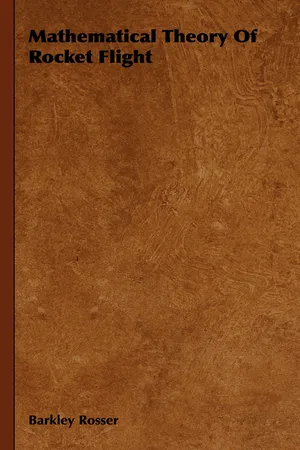
- 284 pages
- English
- ePUB (mobile friendly)
- Available on iOS & Android
eBook - ePub
Mathematical Theory Of Rocket Flight
About this book
This is the official final report to the Office of Scientific Research and Development concerning the work done on the exterior ballistics of fin-stabilized rocket projectiles under the supervision of Section H of Division 3 of the National Defense Research Committee at the Allegany Ballistics Laboratory during 1944 and 1945, when the laboratory was operated by The George Washington University under contract OEMsr-273 with the Office of Scientific Research and Development. As such, its official title is "Final Report No. B2.2 of the Allegany Ballistics Laboratory, OSRD 5878."
After the removal of secrecy restrictions on this report, a considerable amount of expository material was added. It is our hope that thereby the report has been made readable for anyone interested in the flight of rockets. Two slightly different types of readers are anticipated. One is the trained scientist who has had no previous experience with rockets. The other is the person with little scientific training who is interested in what makes a rocket go. The first type of reader should be able to comprehend the report in its entirety. For the benefit of the second type of reader, who will wish to skip the more mathematical portions, we have attempted to supply simple explanations at the beginnings of most sections telling what is to be accomplished in those sections. It is our hope that a reader can, if so minded, skip most of the mathematics and still be able to form a general idea of rocket flight.
Frequently asked questions
Yes, you can cancel anytime from the Subscription tab in your account settings on the Perlego website. Your subscription will stay active until the end of your current billing period. Learn how to cancel your subscription.
At the moment all of our mobile-responsive ePub books are available to download via the app. Most of our PDFs are also available to download and we're working on making the final remaining ones downloadable now. Learn more here.
Perlego offers two plans: Essential and Complete
- Essential is ideal for learners and professionals who enjoy exploring a wide range of subjects. Access the Essential Library with 800,000+ trusted titles and best-sellers across business, personal growth, and the humanities. Includes unlimited reading time and Standard Read Aloud voice.
- Complete: Perfect for advanced learners and researchers needing full, unrestricted access. Unlock 1.4M+ books across hundreds of subjects, including academic and specialized titles. The Complete Plan also includes advanced features like Premium Read Aloud and Research Assistant.
We are an online textbook subscription service, where you can get access to an entire online library for less than the price of a single book per month. With over 1 million books across 1000+ topics, we’ve got you covered! Learn more here.
Look out for the read-aloud symbol on your next book to see if you can listen to it. The read-aloud tool reads text aloud for you, highlighting the text as it is being read. You can pause it, speed it up and slow it down. Learn more here.
Yes! You can use the Perlego app on both iOS or Android devices to read anytime, anywhere — even offline. Perfect for commutes or when you’re on the go.
Please note we cannot support devices running on iOS 13 and Android 7 or earlier. Learn more about using the app.
Please note we cannot support devices running on iOS 13 and Android 7 or earlier. Learn more about using the app.
Yes, you can access Mathematical Theory Of Rocket Flight by Barkley Rosser in PDF and/or ePUB format, as well as other popular books in Mathematics & Mathematics General. We have over one million books available in our catalogue for you to explore.
Information
Table of contents
- Cover
- Title
- Copyright
- Preface
- Contents
- Chapter I The Equations of Motion of a Rocket
- Chapter II Motion After Burning
- Chapter III Motion During Burning
- Chapter IV Boundary Conditions
- Chapter V Properties of the Rocket Functions
- Appendixes
- Bibliography
- Glossary of Symbols
- Index